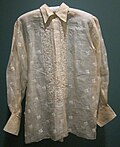islands. Abacá cloth with a more delicate texture is called tinampipi. While especially fine lace-like abacá cloth is called nipis or lupis. Fine abacá fibers...
38 KB (3,875 words) - 05:25, 8 November 2024
Abaca slippers are made from dried abacá plants and leaves, as well as sometimes from dried pineapple plant leaves. Abaca slippers may be found in the...
841 bytes (66 words) - 20:04, 26 January 2023
of files. The paper was traditionally produced with manila fibers from abacá leaves, also known as manila hemp. This material was named after Manila...
6 KB (627 words) - 10:30, 10 September 2024
Abaca bunchy top virus (ABTV) is a pathogenic plant virus of the family Nanoviridae. ABTV has been isolated from both abacá (Musa textilis) and banana...
3 KB (274 words) - 22:40, 26 November 2022
manila hemp (a.k.a. abacá leaves), which was named after Manila, the capital of the Philippines. Beginning in the 1840s, recycled abacá rope fibers were...
10 KB (984 words) - 04:58, 25 October 2024
year during the fourth week of May. It recognizes the importance of the abacá fiber and the Manila hemp industry for the local economy. The festival also...
3 KB (295 words) - 03:46, 22 July 2024
(coir, ramie, sisal, cotton, flax, hemp, jute, kapok, kenaf, moss, linen, abacá, etc.) Animal fiber (wool, silk, alpaca, camel, angora, cashmere, mohair...
2 KB (195 words) - 07:08, 5 August 2024
Abaca bract mosaic virus (ABrMV) is a plant pathogenic virus. It is transmitted by Pentalonia nigronervosa, Aphis gossypii, and Rhopalosiphum maidis....
2 KB (195 words) - 23:45, 15 October 2024
production of cloth during the abaca fiber selection and stripping process. The fibers are taken from the stalk of the abacá (Musa textilis), a banana plant...
13 KB (1,391 words) - 11:03, 30 August 2024
It is traditionally made with sheer textiles (nipis) woven from piña or abacá; although in modern times, cheaper materials like organza silk, ramie or...
36 KB (4,054 words) - 16:59, 13 October 2024






